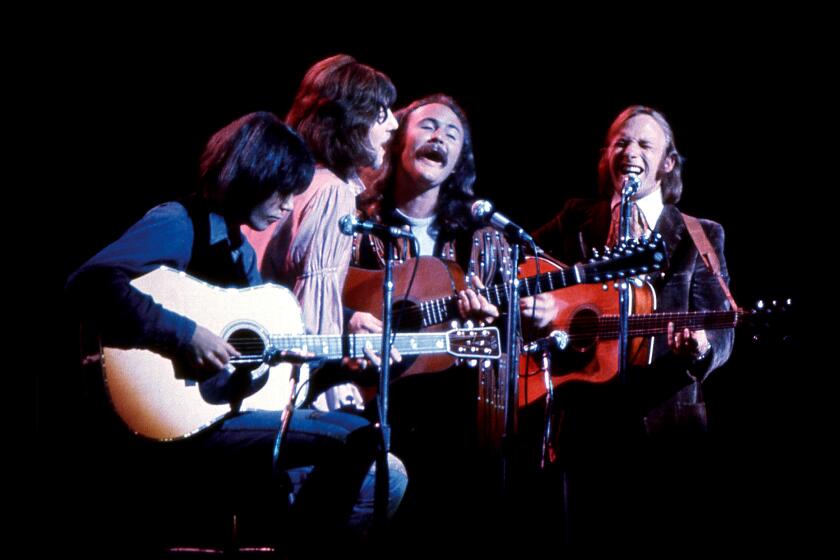Spirits of the Electronic World
- Share via
May Day is noise day. Demonstrators take to the streets; revelers too. Wednesday night, leaving downtown for midtown, one could hear the sounds of 10,000 marchers on Spring Street demanding rights for illegal immigrants; listen to a radio report about a million in Paris protesting Le Pen; and then, facing blaring boring music from a private fund-raising party, attempt to walk up the steps of the Los Angeles County Museum of Art, past guards stationed to divert concertgoers. Ironically, all we were after was more, if fresher and artful, noise in the Leo S. Bing Theater.
The concert was the blowout of the California EAR Unit’s 20th anniversary season, but it was called “Brown Out.” On this evening, noise, along with a hint of political protest, was this ever-mutable ensemble’s metier. The six superb players of conventional instruments variably confronted, collided with, marched in lock step with and outwitted the electronic ether, with the secret sounds your computer makes, with the sounds of sophisticated Space Age gear, with the amplified ritual of the world around us. A lot of it was loud; some of it was interesting; much of it was new.
The most ambitious piece was a premiere by Laetitia Sonami, an Oakland-based composer who has been picking up prestigious prizes lately (she just won this year’s Herb Alpert Award in Music). “A Blind Ride” modifies sounds apparently hidden in electronic documents and spreadsheets, over which the musicians improvise. Variously placed lightbulbs illuminate the stage in brief bursts.
Who knows quite what she was up to on the darkened stage--framed by four glowing blue dots of lights from the loudspeakers--with her homemade “lady’s glove,” full of embedded sensors that let her control sound and the lightbulbs. Still, Sonami’s electronic, computer-document-derived noises revealed a fascinating papery texture that was not just satisfyingly visceral, but, at least to one writer not always happily glued to his machine, downright comforting. The ensemble played mostly floating fragments that made a beautiful fit with the rustling, swirling electronics.
Nicholas Francis Chase, a recent CalArts graduate, picked up his electronic ideas from scratch DJs in “OPUS,” in which the composer manned two turntables. Breaking up his new piece into turntable duets with piano and percussion, trios with winds and strings, and a fifth section for all the players, Chase has a fine ear for combinations of sounds. Flamboyant music for pianist Vicky Ray made intriguing counterpoint with a hand-modulated piano recording (Brahms’ “Paganini” Variations?).
Chase amusingly challenged violin and cello with a stuck record, sent bass flute and bass clarinet into scat song with amplified scratches, and created a percussion extravaganza for Amy Knoles. Not exactly fleet-fingered, however, Chase broke the piece’s momentum with long pauses as he gingerly changed records and adjusted his score between each section, making the finale an anticlimax.
Three other pieces pitted solo instruments against the machine. In Anna Rubin’s “Landmine,” written last year and receiving its Los Angeles premiere, Dorothy Stone’s live flute, often electronically thickened, added moody atmosphere to a pre-recorded, digitally dithered text about the land mine crisis in Cambodia.
Clarinetist Marty Walker gave the premiere of a new version of Barney Childs’ “The Edge of the World.” Originally for live organ accompaniment, Walker has adapted the 1981 piece--written for him by Childs, who died in 2000--with an electronically realized organ part, making it seem all the more a haunted landscape as the bass clarinet improvises over insistent, sonically exaggerated diapason chords.
Although receiving a local premiere, Eric Chasalow’s “Hanging in the Balance” for cello and electronic sounds was the oldie of the evening, not so much because it was written in 1983, but because the electronics had the flavor of the back-to-the-future Space Age bleeps and bloops of the ‘50s and ‘60s. Still, Erika Duke-Kirkpatrick’s exciting performance (from memory), and the piece’s brief duration made it hang on, if just, in the present.
For Mark Trayle’s premiere, “Periodic transmission at regular intervals (are not allowed),” crabbed phrases played by violin (Robin Lorentz), cello, flute and percussion were tracked by a chirping computer. Typical of these machines, when given leeway, they want all the attention for themselves whether they have anything to say or not.
Obviously in the early stages of evolution, geek musique needs all the help it can get from real musicians. In the case of the EAR Unit, it is actually getting it. I just hope the machines are paying attention as well.
More to Read
The biggest entertainment stories
Get our big stories about Hollywood, film, television, music, arts, culture and more right in your inbox as soon as they publish.
You may occasionally receive promotional content from the Los Angeles Times.











